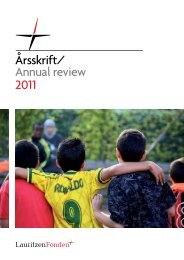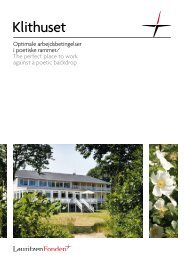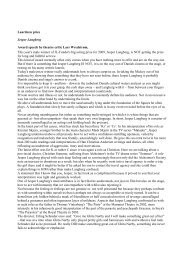Historieinteresseret? - Lauritzen Fonden
Historieinteresseret? - Lauritzen Fonden
Historieinteresseret? - Lauritzen Fonden
You also want an ePaper? Increase the reach of your titles
YUMPU automatically turns print PDFs into web optimized ePapers that Google loves.
Byens og Næringslivets Historie, De Danske Byerhverv i<br />
tekst og billeder – Jylland, Odense 1907, p. 12f, Søren Alkærsig:<br />
Esbjerg – Havn og By, Esbjerg 1909, p. 113, Poul<br />
Holm: Den flåde vi ikke fik – Danske damptrawlere i Nordsøen<br />
og ved Island, 1887-1903, Sjæk’len – Årbog for Fiskeri-<br />
og Søfartsmuseet 1991, Esbjerg 1992, p. 49ff.<br />
14. Søren Alkærsig: Havnens, Byens og Næringslivets Historie,<br />
De Danske Byerhverv i tekst og billeder – Jylland,<br />
Odense 1907, p. 15, Poul Holm: Tre foretagere på Esbjerg<br />
Havn – Firmaet C. Breinholt, 1875-1953, Sjæk’len – Årbog<br />
for Fiskeri- og Søfartsmuseet 1995, Esbjerg 1996, p. 70ff.,<br />
Ole Lange: op. cit., København 1995, p. 43ff.<br />
15. Salomon J. Frifelt: op. cit., København 1939, p. 84ff og<br />
274ff, Morten Hahn-Pedersen: op. cit., Esbjerg 1993, p. 59,<br />
René Taudal Poulsen: Rederiet ”Dania”, 1900-1966, i Hahn-<br />
Pedersen, Morten (red.), Sjæk’len – Årbog for Fiskeri- og<br />
Ditlev <strong>Lauritzen</strong> og plantagerne<br />
Da <strong>Lauritzen</strong> flyttede til Esbjerg, var området skovløst<br />
og forblæst. Nørreskoven, Vognsbølparken og Solbjerg<br />
Plantage mellem Esbjerg og Bramming er endnu synlige<br />
resultater af initiativer, som Ditlev <strong>Lauritzen</strong> og andre<br />
med interesse for plantningssagen tog op i årene omkring<br />
1900. Kilde: Salomon J. Frifelt: Konsulen, København<br />
1939, p. 189ff.<br />
Nørreskoven er et af mange initiativer, som nutidens Esbjergensere<br />
kan takke Ditlev <strong>Lauritzen</strong> for. Foto: Torben Meyer.<br />
Søfartsmuseet, Saltvandsakvariet i Esbjerg 1999, Esbjerg<br />
2000, p. 55ff., Ole Lange: op. cit., København 1995, p. 34ff.,<br />
Morten Hahn-Pedersen: op. cit., Esbjerg 2001, p. 136ff,<br />
Bent Mikkelsen: op. cit., Ringkøbing 2009, bd. 7, p. 12ff.<br />
16. Salomon J. Frifelt: op. cit., København 1939, p. 207ff,<br />
241ff, Ole Lange: op. cit., København 1995, p. 40f, Morten<br />
Hahn-Pedersen: op. cit., Esbjerg 1993, p. 60f. Verner Bruhn:<br />
op. cit., Esbjerg 1994, p. 292ff. <strong>Lauritzen</strong>s værftsplaner<br />
blev siden realiseret med bygningen af Køge Skibsværft i<br />
1919-20 samt senere overtagelse af værfter i bl.a. Helsingør,<br />
Frederikshavn og Ålborg (Salomon J. Frifelt: op. cit.,<br />
København 1939, p. 244, Søren Thorsøe: op. cit., Kendal<br />
1984, p. 23).<br />
17. Salomon J. Frifelt: op. cit., København 1939, p. 279f.<br />
18. Salomon J. Frifelt: op. cit., København 1939, p. 244ff,,<br />
273ff., Søren Thorsøe: op. cit., Kendal 1984, p. 12f., Ole<br />
Damperen ”Dorthea” blev bygget til ”Vesterhavet” i 1915 og<br />
minesprængt året efter. Ikke mindst årene under 1. Verdenskrig<br />
gav Esbjerg Bombebøsse berettigelse. Gouache, signeret<br />
Johansen, dateret 1916.<br />
Ditlev <strong>Lauritzen</strong> og hjælp til søfarende<br />
Esbjerg Bombebøsse er en velgørende forening, som<br />
yder økonomisk støtte til værdig trængende søfarende fra<br />
Esbjerg-flåden eller disses efterladte. Ditlev <strong>Lauritzen</strong><br />
tog initiativ til foreningens oprettelse i 1901 og fungerede<br />
som dens formand frem til sin død i 1935. Kilde: Søren<br />
Byskov: Esbjerg Bombebøsse 1901-2001, Sjæk’len<br />
2001, Esbjerg 2002, p. 69ff.<br />
Lange: op. cit., København 1995, p. 45ff.<br />
19. Salomon J. Frifelt: op. cit., København 1939, p. 154,<br />
248ff, 412ff. samt www.lauri.dk, www.valsemøllen.dk og<br />
www.esbjergbyhistoriskearkiv.dk.<br />
20. www.lauritzenfonden.com samt skrivelse af 18/12-2009<br />
betitlet "<strong>Lauritzen</strong>-gruppen forenkler koncernstruktur", signeret<br />
Jens Ditlev <strong>Lauritzen</strong>. I tillæg til <strong>Lauritzen</strong>-gruppens<br />
rederi-, transport- og logistikaktiviteter har LF Investment<br />
ApS aktier i en række virksomheder inden for olieanalyse,<br />
måleinstrumenter, software, bioteknologi og ejendomme.<br />
21. Morten Hahn-Pedersen: Danish North Sea Passenger<br />
Lines since 1850, i Hahn-Pedersen, Morten (ed.): North<br />
Sea Passenger Lines, Esbjerg 2009, p. 34ff, Morten Hahn-<br />
Pedersen: op. cit., Esbjerg 2001, p. 119ff., Ole Lange: op.<br />
cit., København 1995, p. 223ff.<br />
Summary<br />
Ditlev <strong>Lauritzen</strong> (1859-1935) was one of the entrepreneurs<br />
who realised the need to exploit the opportunities which appeared<br />
with the establishment of Esbjerg Harbour. <strong>Lauritzen</strong><br />
was a merchant, and it was as a merchant that he established<br />
himself in Esbjerg’s expanding construction market in the<br />
mid-1880s, selling timber and coal and later also builders’<br />
supplies. But he quickly saw the potential which lay in the<br />
growing cooperative movement, and he soon started to import<br />
fodder and artificial fertiliser, and exported butter to<br />
the areas with which he was doing business. The company’s<br />
growing turnover led to an increased need for tonnage and<br />
the gaining of control over the freight costs, and <strong>Lauritzen</strong><br />
gradually turned to steam ships which, despite continuing<br />
investments in trade and later also industry, finished up being<br />
his most important activity. His involvement in the formation<br />
of a local telephone company and two local banks<br />
also indicates a person with an eye for providing the new<br />
town with infrastructure and institutions which met his commercial<br />
needs. However, he didn’t manage to avoid failed<br />
investments: his investments in both the fishing and trading<br />
company Islandsk-Færøisk Kompagni (the Icelandic-Faeroese<br />
Company) and the shipping line Scandia failed.<br />
<strong>Lauritzen</strong> ran his business via an extensive network. The<br />
Fanø Island captain Søren Meinertz was a partner in several<br />
of <strong>Lauritzen</strong>’s initiatives – not least in relation to steam<br />
ships – and the Breinholts were among the many local Esbjergers<br />
with whom he had business dealings. But <strong>Lauritzen</strong><br />
also built up contacts beyond Esbjerg – primarily in West<br />
Jutland, but also in Copenhagen – and depending on the nature<br />
of the individual initiative, managements and boards<br />
of directors were comprised on the basis of the members’<br />
ability to contribute capital or expertise. To manage his own<br />
companies, <strong>Lauritzen</strong> typically recruited people with both a<br />
knowledge of, and business sense in, the area – even if suitable<br />
candidates had to be imported from abroad, as was the<br />
case with the managers of the steam ship companies Jylland<br />
and Dania.<br />
<strong>Lauritzen</strong> constantly extended his own activities throughout<br />
the 1880s, but during the 1890s he changed style and<br />
began to separate the biggest business areas into separate<br />
companies with their own managements, thus facilitating<br />
his overview of the many activities, but he retained control<br />
as chairman of the boards of directors of the companies.<br />
The same strategy was followed when he entered hitherto<br />
uncharted areas, where he also exerted his influence via<br />
shareholdings or control via a chairmanship of the board of<br />
directors, depending on the size of the investment.<br />
But in the steamship company Vesterhavet, <strong>Lauritzen</strong><br />
placed himself firmly at the rudder right from the start via a<br />
genuine double role as both chairman of the board of directors<br />
and general manager. <strong>Lauritzen</strong> strengthened his position<br />
over the years as principal shareholder in the company,<br />
whose strategy was controlled expansion with a high degree<br />
of own financing and limited borrowing. New tonnage was<br />
procured when the market was low, loans were only taken<br />
out on favourable terms, and building up equity was helped<br />
by limited allocations of dividends to shareholders relative<br />
to the size of the profit which was gained. In a mere 15<br />
years, this strategy made Vesterhavet one of Denmark’s biggest<br />
shipping lines. From a simple merchant, <strong>Lauritzen</strong> had<br />
become a ship owner, and as such his business needs were<br />
such that in 1914, his business headquarters had to move to<br />
Copenhagen.<br />
22 23





